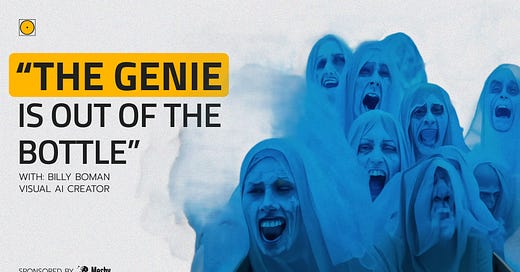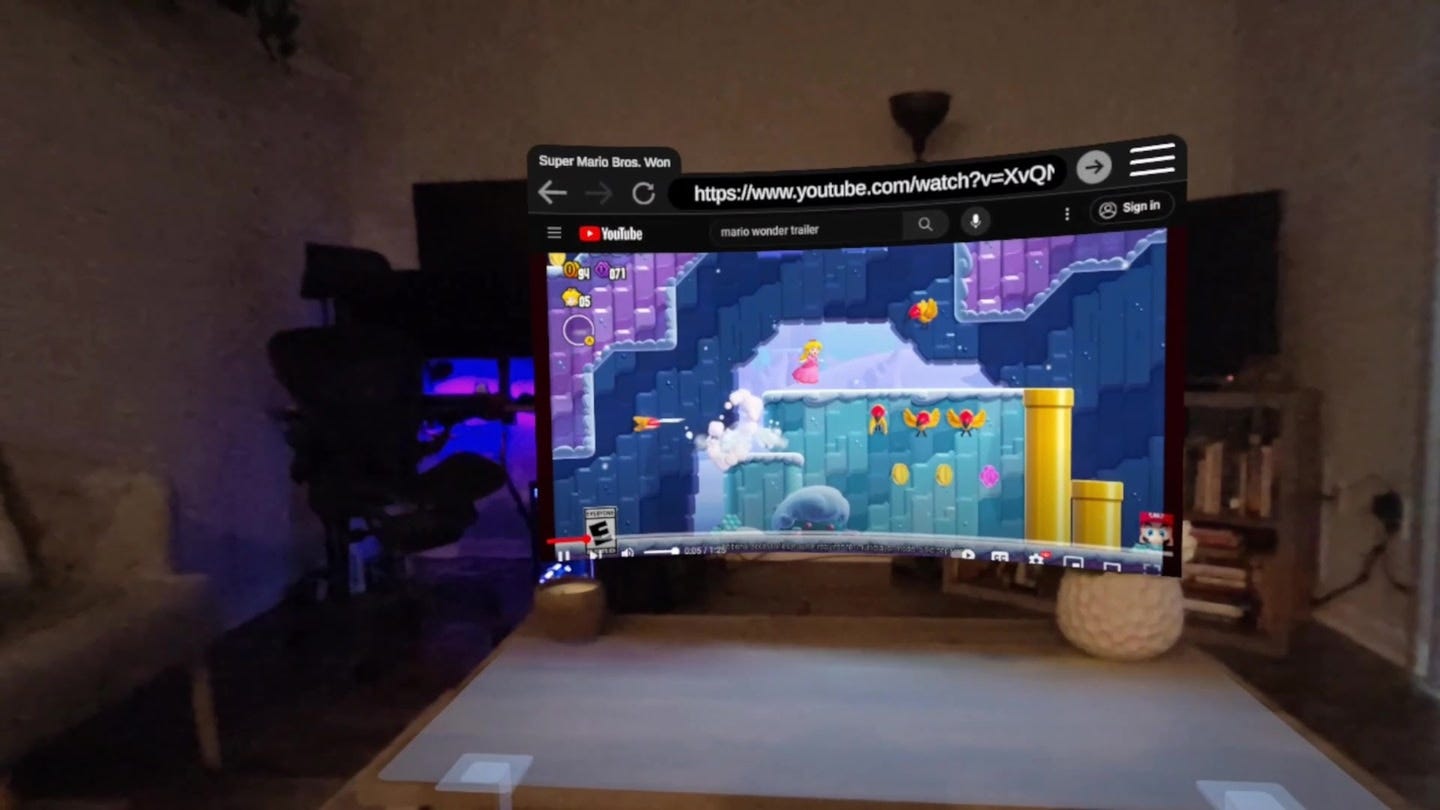From Designer to Video Producer Using Gen-AI
Billy Boman is a designer turned video creator thanks to the help of AI. He has worked with world-famous brands and artists like Fred Durst and Intel and in this conversation he shares his process, unique tools, and how to pitch his services to clients. For the product spotlight I am going to share one of the most immersive video player you can try right now on your Quest.
The newsletter is also shared with our 10k audience on LinkedIn and if you would like to become a sponsor just answer this email or contact me on LinkedIn 👉 Gabriele Romagnoli.
Interview with Billy Boman
How do you balance creativity and control when co-creating with AI?
Billy Boman: Using AI feels like directing a fluid intelligence. You guide it with prompts, but it often surprises you with unexpected results. It’s like directing actors who occasionally improvise—those moments can bring magic. You have to let go of complete control and embrace the unpredictability while steering the process toward your vision. It’s about blending structure with spontaneity to create something truly unique.
How do you ensure a cohesive visual style across your projects?
Billy Boman: Cohesion comes from consistency in style, color, and lighting. I do a lot of post-production and color correction in tools like After Effects to help smooth over any inconsistencies. It’s about creating a seamless viewing experience where every element feels intentional, even when using a mix of AI tools and techniques.
What’s one AI tool you wish existed to make your work easier?
Billy Boman: I’d love a fully integrated pipeline combining image generation, video generation, and editing. Currently, I use seven to ten different tools to produce a single project, which is time-consuming. A unified platform would streamline the process, making it easier to focus on storytelling and creativity rather than technical workflows and tool juggling.
How do you find inspiration for your AI projects?
Billy Boman: Inspiration comes from everywhere—art, literature, music, and even classical works. For instance, the hurricane of souls from Dante’s Inferno inspired a key sequence in the Fred Durst video. I love blending timeless ideas with cutting-edge tools. AI allows me to reinterpret these inspirations in ways that feel fresh and visually captivating.
What makes music videos particularly suited for AI-generated content?
Billy Boman: Music videos are ideal for AI because they’re fast-paced, allowing for short, dynamic scenes. This format minimizes continuity issues AI can struggle with over longer shots. They’re also visually experimental, which plays to AI’s strengths in creating bold, imaginative imagery. Music videos are a perfect playground for exploring what AI can do while matching visuals to the energy and emotion of the music.
Why was working with Fred Durst a milestone for you?
Billy Boman: Growing up, Fred Durst was an icon in the music scene, so working with him felt surreal. It was my first project as a solo creator, where I handled everything—image generation, video, and editing. Reaching nearly 300K views on YouTube and seeing global reactions was incredible. For me, it marked a shift from being a designer to fully embracing my role as a visual storyteller, using AI to bring my creative visions to life.
Can you tell us about the challenges you faced when working on the music video with Fred Durst project using AI tools?
Billy Boman: This project was full of challenges. One standout was Fred Durst's backward red cap—a signature look. AI models simply couldn’t generate it correctly, even after over 100 iterations. Ultimately, I used Photoshop’s generative fill to fix it frame by frame. It’s a testament to the fact that AI tools still need human problem-solving to deliver a cohesive final product
You’ve faced challenges using AI tools on a Mac. How have you adapted?
Billy Boman: Using a Mac in AI work is tough since most open-source tools are optimized for PCs. I’ve adapted by using hosted workflows like Think Diffus and RunComfy, which let me access powerful tools remotely. These platforms allow me to bridge the Mac-PC gap and leverage cutting-edge AI capabilities. It’s not perfect, but it’s a compromise that lets me push the creative boundaries despite the platform's limitations.
Can you explain your process for video-to-video transformations?
Billy Boman: Video-to-video is underrated but incredibly powerful. For example, in my Motionless in White remake🔗, I used style transfer to add a Gothic zombie aesthetic. This technique lets you transform existing footage while preserving motion. I’ve also layered AI-generated visuals onto live-action footage to create surreal effects. It’s a tool with immense potential for reimagining stories and visuals.
What opportunities do you see for AI video beyond music?
Billy Boman: Commercials are a great fit for AI because they’re short and rely on striking visuals. AI excels at creating fantastical, eye-catching imagery that stands out. For example, the coffee ad I made leaned into AI’s strength in generating magical effects like dust transforming into beans. These projects show how AI can elevate branding by merging creativity with production efficiency.
What’s the most important skill for an AI artist to develop?
Billy Boman: Adaptability is crucial. AI tools evolve quickly, so staying up to date is essential. Beyond technical skills, storytelling is what makes your work resonate. The tools are only as good as the vision behind them. Being able to think creatively while adapting to new technologies ensures you stay relevant and continue to produce meaningful, impactful work.
How do you educate clients about what’s possible with AI?
Billy Boman: Educating clients is key. I explain that AI isn’t CGI on a budget—it’s a unique medium with its strengths and limitations. I showcase examples of past projects to illustrate what’s possible and discuss how AI can enhance their vision. Setting realistic expectations while highlighting the creative potential helps clients understand and embrace AI as part of the process.
How do you deal with negative reactions to AI in your work?
Billy Boman: Negative reactions often come from fear or misunderstanding. Many think AI is replacing creativity when it’s really just a tool for enhancing it. I address concerns by explaining my process—it’s not just pushing a button; it’s problem-solving and refining. Most importantly, I remind critics that many projects, like the Fred Durst video, wouldn’t exist without AI due to budget or technical constraints.
What advice would you give to someone starting in Gen-AI for video creation?
Billy Boman: Dive in without fear. AI is a new frontier, and there’s no right way to use it yet. Experimentation is key—play with different tools, make mistakes, and find your style. Focus on storytelling because that’s what will set your work apart. Learn the tools, but let your creativity lead the way. It’s an exciting time to be in this space.
Check out the full conversation 👇
Product Spotlight: Luminar
There are several movie players that you can use on your HMD to watch movies on a HUGE virtual screen. They all offer different functionalities supporting various file formats but when it comes to playing a movie in mixed reality nothing beats Luminar. When using this app you get some stunning shadows and reflection of the content on the screen on your physical environment and furniture and it really brings the viewing experience to another level. I feel more MR apps should find ways to use effectively shadows reflection and occlusion to blend real and virtuals more seamlessly.
If you have any other recommendations just drop me a message and I would love to try it out.








